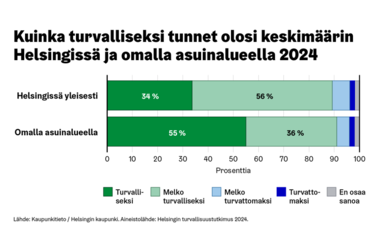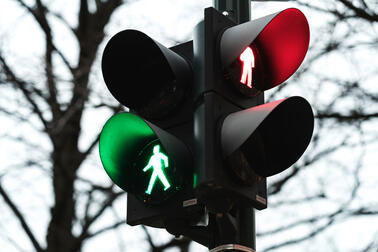
Helsinki understood the dangers of detrimental segregation in residential areas early on, and thus, the city has been successfully implementing social mixing in its housing policy for over 50 years. Diversity, dialogue and well-designed structures are the foundation for a safe Helsinki.
At the turn of the 1950s and 60s, a new extensive residential area was built in Siilitie, Helsinki, becoming a home to people sharing largely similar circumstances in life. The absence of prospects and housing segregation erupted in gang fights, and the city awakened to the problems of housing that lacks diversity. After this, Helsinki has decisively pursued policies that introduce social mixing in different residential areas.
"This model has been celebrated and has saved us from many ills. Whilst in many countries certain areas are turning into slums, here even the weaker residential areas are versatile. Even the coronavirus has not centred as clearly in certain areas as it has in other countries," tells Mari Randell, the City of Helsinki's housing programme manager.
City of Helsinki Housing Programme Manager Mari Randell
Randell believes that safety should be discussed on many levels, because we are talking about how things are experienced. When people are on their own turf, they can interpret situations and areas, but when they go to an area they do not know, they are not as aware.
"A good example of this is Myllypuro, which was considered a notorious and unsafe place by those who did not live there. In fact, there was no reason for people from other city districts to visit Myllypuro. Now that the Liikuntamylly sports facility attracts visitors and study places increase the volume of people, the image of the area has changed. That image is no longer based on old newspaper articles; now people actually visit the place and know the area," Randell explains.
The police have also realised the impact the media has on people's ideas about the safety of residential areas.
"The news we receive of certain areas may be solely negative even if the problems were relatively insignificant. The police might have been working on a case considered fairly small for some time when the media picks up on it. Thus, the police may not manage to provide the facts or put the residential safety-related situation into perspective before the controversial headlines have already been published and people's imaginations fed with powerful images. It is regrettable and has long-reaching consequences," says Chief Inspector Katja Nissinen at the Helsinki Police Department's Preventive Policing Unit.
Chief Inspector Katja Nissinen's work at the Preventive Policing Unit of the Helsinki Police Department also involves issues related to the safety of residential areas.
Entry routes determine the feeling of safety
Work is done on different levels from planning to solving new problems to promote the safety of residential areas.
From the perspective of urban planning, the feeling of safety in residential areas is determined largely based on the entry routes.
"If you feel unsafe at the station as you step out of the metro, that marks the whole area. The same applies to marketplaces, squares and parks. That is why we must focus on them," notes Mari Randell.
The police carry out close, regional work on stations and, for example, in shopping centres.
"We have an important role in residential areas in preventive work. When residents know that they can phone or email us directly, many issues that start off small will not have the time to develop into something bigger. Information is passed from mouth to mouth, and seldom a safety related problem comes as a surprise to the police. Often, problems are confined to certain places and areas, and we investigate them with our networks. We know who can settle a situation; we bring the right people together with an aim to discuss solutions and agree on measures to solve the issue," Katja Nissinen explains the police's regional approach.
"A good example of this is the recent situation in Pikku Huopalahti where young people had started demonstrating antisocial behaviour. The police looked for solutions for the situation; we engaged the parents and discussed with the young people, and together we found sound activities for them. The situation was successfully diffused before anything more serious had happened," Nissinen explains with satisfaction.
"In some areas, day centre activities for substance abusers may cause disruption that is frightening for others. Fear creates polarisation, and in this, the police have a clear duty to promote harmony and functionality and aim to reduce antagonism. We cannot take sides at the police; instead, we must promote the feeling of safety to ensure that everyone feels good about moving about in their own area," says Chief Inspector Nissinen.
Residential areas’ structures can widen horizons
When Helsinki builds new residential areas, Housing Programme Manager Mari Randell's unit assesses what kinds of housing management and funding forms should be implemented in the new area.
"As an example, if the area will feature 5,000 new homes, we calculate how many new rental homes, owner-occupied homes and right-of-occupancy flats should be built. For instance, an entire block can never be built solely as owner-occupied homes. With infill projects, the aim is always to diversify the existing structure of the area. Residential areas do not become less diverse because of low-income people or immigrants but because people moving up in the world move away from the area as their first child is born. That is why the aim is to offer different housing models in the same area, so that people would stay in the area long-term even as the situations in their lives change.
The diversity of housing in residential areas also impacts the future, according to Randell.
"Insecurity and inequality go hand in hand. If the feeling of inequality is strong, people feel that they do not have control over their own life and that leads to indifference. That sows the seed of social misconduct. When the same block includes people occupying different styles of housing, children too see more opportunities for their future."
Things considered self-evident by Finns shape urban planning
Homelessness is relatively low in Helsinki compared to many other European capitals. Nowadays, homelessness is only rarely caused by the lack of a dwelling – there tend to be other underlying problems. Of course, there are people who spend their nights on the streets and undocumented migrants, but students' mattress accommodation has not been needed for several years. The housing situation in the city has improved, and that automatically improves the feeling of safety.
So why does the city of Helsinki implement exactly these kinds of housing policies? According to Mari Randell, Finns’ firm belief that people's origins should not define their future dates back to the country's past.
"We have not become a society in which parents choose their children's schools and the family's place of residence based on their wealth. Foreigners often ask about children being sent to the local school. To us that's self-evident – we have social responsibility. Owner-occupied housing is relatively widely spread, and it tends not to be funded through inheritance; it can also be achieved through work. Us Finns have an engineer's way of thinking: we are not prepared to give up our children's right to walk independently to school – we would rather fix traffic problems in order to safeguard children's school journeys.
Iframe not supported
The article is part of the Nordic Safe Cities alliance's Safe City Tour.
Nordic Safe Cities(Link leads to external service)
(NSC), established by the Nordic Council of Ministers in 2016, is a non-profit network focusing on safety in the Nordic countries. The NSC activities aim to have a positive impact on safety in cities and to stand against polarisation and violent extremism. Helsinki has participated in the network's activities from the start.
Text: Vilja Roihu / Stooritaivas Oy
Images: Aki Rahikka / Stooritaivas Oy


